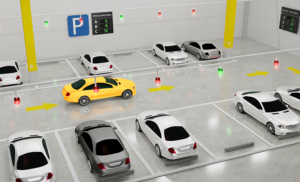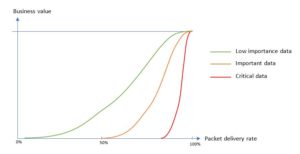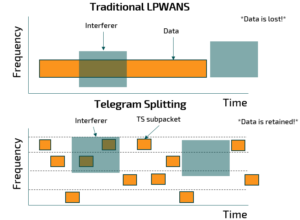All LPWAN connected sensors serve a purpose, they generate some insight. This insight is used in a business process to generate value for the business or their customer.
Let us exemplify:
- A parking sensor sends data each time a parking place is occupied or made available. This data can be used to guide the cars to the correct parking space and make parking easier. This is a value for the car drivers and reduces stress.
- A water meter detects usage of water. Water usage is reported each hour. This data is a huge value to the water company enabling accurate on time billing, hourly tariff breakdowns, and quick leakage detection.
- An indoor air quality sensor measures air quality (Temperature, humidity, VOC gas content). This data is used to control HVAC systems. This creates value for the building owner as it minimizes energy usage while making sure the working environment is optimal for workers.
One of the major challenges for LPWANs in Europe is that the normal Quality of Service (QoS) achieved with acknowledgement and retransmission cannot be done with reasonable sized installations. This is due to EU regulation preventing high duty cycles on gateways.
Due to this lack of feedback loop, LPWANs must employ a feed forward mechanism. They must add features to the outgoing packet to increase the probability that it is received in a noisy environment. Examples of such features include repeating the same message several times or Forward Error Coding (FEC).
The License Free Bands Are Getting Crowded
An important consideration for companies entering this market is that the license free bands are getting full of traffic. The observed generic noise level in these bands have increased over the last years. The noise is bursty in nature since much of it is generated from other license free band radios or LTE base stations in the area.
Studies have shown that in area of many wireless transmitters, the packet loss of a general LPWAN solution can easily go above 10%.
What the actual packet delivery rate will be in an actual deployment 5 years from now is hard to predict. Pilot testing with a few devices can be an indication, but it can also give false expectations. When you add more devices to the field and other companies are doing the same the packet delivery rate may be reduced significantly.
How Much Data Can Be Lost?
Then the big question comes. How much data can be lost before the value is decreased?
How many frustrated drivers need to find a green light indicating an open parking spot in an ocean of red lights (occupied) only to find out the sensor does not work and the spot is actually occupied before the car park owner will demand his money back?
How often can the you lose data from the meter before your system of hourly tariffs breaks down?
The responsibility in understanding the relationship between the packet delivery rate and the business value falls on the end application owner. The figure below is generic but shows how business value varies with packet delivery rate. Note that each application has its own dependency.
The solution
Based on the requirements of many IoT devices, equipment that has been in the field for many years and, an ever-growing occupancy of license free bands, a huge business risk is created for anybody using LPWANs. Therefore, a solution must be found to improve data reliability.
One of the solutions to this growing issue is called MIOTY! MIOTY is a newly launched low-power, wide-area network (LPWAN) protocol that was designed to have the best-in-class reliability and scalability of all available LPWAN technologies today to support massive industrial and commercial IoT deployments.
MIOTY supports telegram splitting– ultra narrowband (TS-UNB) in combination with heavy forward error coding (FEC) which enable a new standard for reliable LPWAN. With Telegram Splitting, MIOTY can split a message into several sub-packets and send them at different times and frequencies. Since the airtime of these subpackets is much shorter than that of existing LPWANs, the chance of collisions with another message is very low and it allows for battery operation. Even if 50% of sub-packets do not make it to the gateway, the full message will be successfully reassembled, aka, no packet losses. Meanwhile a traditional LPWAN like LoRAWAN can have more than 10 % packet loss. For important data and critical data this can mean that the business case disappears.
A single MIOTY network can have many hundreds of thousands of devices which can transmit up to 1.5 million data packets a day to a single gateway, with no loss of information even in hard-to-reach environments where there a lots of physical obstructions and poor propagation properties.
Radiocrafts will be releasing a MIOTY module in the end of Q2 2020, so stay tuned for that!
You can read more about MIOTY here.
You can read more on the MIOTY module datasheet here.
What To Take Away From This?
All LPWAN connected sensors serve a purpose, they generate some insight which is then used to generate value for a business. However, as IoT evolves, more devices are being deployed in the field in the billions. This causes immense amounts of traffic in the license free bands, which in turn creates more noise and interference. With increased noise and interference, you get a higher probability of packet loses, which means the data you collect may no longer create meaningful value for your business. Many solutions are being created to solve this issue. One solution, which is backed by Radiocrafts is MIOTY, a new-changing LPWAN solution for increased reliability and scalability in massive networks.
So, in designing your next generation LPWAN solution you must ask yourself: How much data can you afford to lose?





